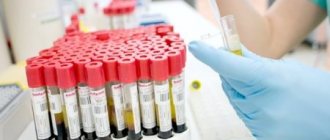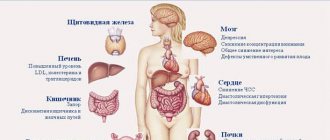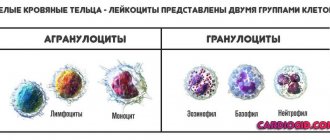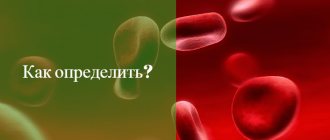Causes of high hemoglobin during pregnancy
Hemoglobin is a protein that contains iron and is a component of red blood cells. It ensures proper gas exchange, adds oxygen to all cells and removes carbon dioxide from them. The level of iron-binding protein largely determines how well the fetus develops.
Throughout pregnancy, a woman’s hemoglobin level changes:
- at the embryonic stage, the level of iron-containing protein ranges from 112 to 160 g/l;
- in the middle of pregnancy the rate decreases and ranges from 100 to 144 g/l;
- before childbirth, the hemoglobin concentration returns to the usual levels of 110-140 g/l.
Important! If the concentration of iron-containing protein is exceeded by less than 20 g/l, the condition is normal. It is caused by the body's adaptation to the upcoming pregnancy. At the end of the first three months the indicator returns to normal.
In the first time after fertilization, due to increased blood flow, the physiological fluid dilutes. Therefore, the level of iron-containing protein decreases slightly. Few women experience elevated hemoglobin during pregnancy. Throughout the entire gestation period, hemoglobin levels are constantly changing. But if they do not go beyond the norm, there is no reason to worry. To determine the levels of iron-containing protein, a general blood test is used. Its high rates develop as a result of another disease or accompany it.
Increased hemoglobin develops in pregnant women suffering from bleeding disorders. The reasons for this condition include:
- hereditary factor;
- deficiency of vitamin B12 or folic acid in the body;
- diseases of the cardiovascular system;
- kidney disease;
- dysfunction of the gastrointestinal tract;
- smoking and other bad habits.
RISK FACTORS
There are 2 known reasons leading to the development of iron deficiency anemia during pregnancy:
- negative iron balance in the body,
- insufficient supply of microelements. During natural childbirth, a woman loses 0.2–0.25 g of iron, and during multiple births and cesarean section - 0.45. As a result, in 30% of women in labor, the hemoglobin concentration drops to 100 g/l, and in 10% - to 80. Such indicators indicate a moderate severity of anemia. During breastfeeding, there is a further decrease in hemoglobin levels associated with lactation (consumption of at least 1 mg of iron per day).
A deficiency of the element in a pregnant woman's body can cause serious problems, including miscarriage. Therefore, expectant mothers should regularly undergo testing to determine their iron content and hemoglobin concentration.
WHAT MEASURES ARE BEING TAKEN
Symptoms of elevated hemoglobin
If a pregnant woman has high levels of iron-containing protein, the woman's well-being worsens. While waiting for a child, susceptibility to any changes increases. Therefore, a high level of hemoglobin protein can be recognized by the following signs:
- constant weakness and drowsiness;
- decreased visual acuity;
- fatigue;
- lack of appetite;
- pale skin:
- disturbances in the functioning of the excretory system;
- increase in blood density.
Although the causes of high hemoglobin protein levels are different, the condition requires correction. Otherwise, the violation threatens the health of the fetus and the pregnant woman herself. For the unborn child, the slightest changes in blood flow can lead to catastrophic consequences. The mother's blood provides the unborn baby with nutrients. If it is too thick, then its passage through the vessels slows down. As a result, the fetus suffers from a lack of nutrients.
Insufficient oxygen supply provokes the development of varicose veins and blood clots. A woman develops cardiovascular diseases, and the likelihood of spontaneous miscarriage in the early stages or premature birth in the last trimester increases. A high amount of iron sometimes causes fetal death and intrauterine development disorders. Before birth, against the background of a high concentration of iron-containing protein, the fetus develops hypoxia. Negative consequences can be avoided by timely normalization of hemoglobin.
Excess glycated hemoglobin during pregnancy
The norm of iron-containing protein depends not only on the period of pregnancy. Its concentration is affected by the woman's age. If the pregnant woman is young, the norm is 6.5%. In middle age this value approaches 7%. For women who have crossed the forty-year mark, the norm is 7.5%.
Glycated hemoglobin is assessed in pregnant women every 45 days. This indicator is important because it reflects the correctness and completeness of the development of the fetus in the mother’s womb. Exceeding the norm negatively affects the development of the child and worsens the woman’s well-being. In this condition, the weight of the fetus is greatly increased. Therefore, childbirth is difficult.
A DELICIOUS ADDITION TO THE DIET
To meet a woman's need for iron during pregnancy and maintain normal hemoglobin levels, it is not enough to eat right. Therefore, hematogen may be recommended as an additional measure during pregnancy and breastfeeding. Taking dietary supplements is decided in consultation with a doctor.
"FERROGEMATOGEN®-PHARMSTANDARD" is a dietary supplement that serves as an additional source of mineral elements (iron and copper) and vitamins (pyridoxine hydrochloride, ascorbic and folic acid). It contains black food albumin, vitamins and microelements, which are in the required ratio for high absorption of iron, which is necessary for the synthesis of hemoglobin and the prevention of anemia during pregnancy.
The composition of the dietary supplement optimizes the conditions for absorption and transport of the element to the site of red blood cell synthesis.
- Without copper, normal absorption of iron is impossible. It is involved in the formation of hemoglobin and bones, as well as hematopoiesis, strengthens blood vessels and prevents the development of osteoporosis.
- Ascorbic acid promotes the absorption of iron and blood clotting, takes part in metabolism, and increases the body's resistance to pathogens of infectious diseases.
- Folic acid is involved in hematopoietic processes, cell division, and regeneration of damaged tissues.
- Pyridoxine hydrochloride takes part in the synthesis of proteins and hemoglobin. Without it, the proper functioning of the nervous system is impossible. "FERROGEMATOGEN®-PHARMSTANDARD" is contraindicated in case of individual intolerance and diabetes mellitus. Before using the drug, consultation with a doctor is required.
Diagnostics
As a rule, a pregnant woman does not feel at all that her level of iron-containing protein is increased. The deviation is detected by chance after a regular blood test or during a sudden deterioration in health. During the next visit to the gynecologist, the specialist examines the woman to exclude the possibility of developing varicose veins.
A blood test is done to determine hemoglobin protein levels. In addition to the general study, a coagulogram is performed, which determines the level of coagulation. During the general examination, the content of hemoglobin protein, ESR indicators, the level of erythrocytes and leukocytes are noted. In a healthy woman, iron-containing protein ranges from 120 to 140 g/l. If the increase in level does not exceed 10%, they speak of physiological thickening. When hemoglobin protein rises above 160 g/l, treatment is necessary.
Important! Additionally, a general laboratory examination of urine analysis is carried out. This is necessary to eliminate the risk of kidney infection. If a pronounced density of blood flow is detected, instrumental diagnostics are performed. It is needed to determine how severely the venous and cardiac circulation is impaired.
To determine the speed of blood flow in the internal organs, some patients undergo duplex ultrasound examination. Exceeding the standard value indicates an increased content of iron-binding protein. If necessary, additional venography is performed. This study shows the condition of the veins and allows you to evaluate prognoses. For phlebography, contrast components are injected into the vessels.
MEDICAL CENTER
Interpretation of study results contains information for the attending physician and is not a diagnosis.
The information in this section should not be used for self-diagnosis or self-treatment. The doctor makes an accurate diagnosis using both the results of this examination and the necessary information from other sources: medical history, results of other examinations, etc. Units of measurement and conversion factors: Units of measurement in STUDIO DOCTOR - mmol/l
Alternative units: mg/dl
Unit conversion: mg/dL *0.0555=>mmol/l
Interpretation of the result:
Previously used criteria
WHO (World Health Organization) criteria, 2006: using a 2-hour version of the exercise test (glucose 75 g) and two blood draws (fasting and 2 hours after exercise), the laboratory criterion for gestational diabetes was considered to be exceeding at least one of the threshold glucose levels - above 7 mmol/l on an empty stomach or above 7.8 mmol/l 2 hours after exercise. New criteria
An international multicenter study examining the relationship between hyperglycemia and adverse pregnancy outcomes (HAPO Study - Hyperglycemia and Adverse Pregnancy Outcomes), conducted in 2000–2006, showed that the previously used criteria for diagnosing gestational diabetes mellitus require revision. Based on the findings of this study, new criteria for diagnosing gestational diabetes were proposed, which are currently supported by WHO, ADA (American Diabetes Association), as well as the consensus opinion of experts from the Russian Association of Endocrinologists and experts from the Russian Association of Obstetricians and Gynecologists, set out in the Russian National consensus “Gestational diabetes mellitus: diagnosis, treatment, postpartum care” (2012). These recommendations are shown in the table (exceeding any of 3 thresholds - fasting, 1 hour or 2 hours after exercise is considered as a laboratory criterion for gestational diabetes).
Threshold values of venous blood glucose for the diagnosis of gestational diabetes when performing a glucose tolerance test with 75 g of glucose.
| Index | Normal pregnancy | Gestational diabetes mellitus | Overt diabetes mellitus |
| Fasting glucose mmol/l | <5,1 | 5,1 -6,9 | >7,0 |
| 1 hour after exercise mmol/l | <10,0 | >10,0 | — |
| 2 hours after exercise mmol/l | <8,5 | 8,5 — 11,0 | > 11,1 |
Treatment options
During pregnancy, correction of iron protein levels is not always carried out. If the excess of the norm is insignificant, the indicator does not require reduction. Treatment is carried out in case of pronounced clinical symptoms or in the presence of other diseases that affect the state of hemoglobin. All deviations in blood flow are perceived as a symptom of other diseases. To treat pregnant women, gentle methods are used - diet correction, traditional medicine. Medicines are used as a last resort.
Therapeutic diet
A high hemoglobin level is the reason for following a special diet. A woman is recommended to drink a lot of clean water throughout the day. The liquid helps normalize the rheological properties of blood. Red meat and products made from it are excluded from the diet. This is necessary to reduce exogenous sources of iron-containing protein production. Instead, they eat white meat. It contributes to the gradual normalization of hemoglobin levels.
To reduce the concentration of iron-binding protein, adhere to the following recommendations:
- The menu is varied. It includes products containing beneficial microelements, except iron.
- Drink a lot of clean water. The required volume of liquid is calculated at the rate of 30 ml for every 1 kg of body weight.
- Fried and fatty foods are excluded from the menu. The diet is supplemented with fruits and berries.
- Products are boiled or stewed, excluding frying.
If the hemoglobin level is slightly exceeded, a therapeutic diet is sufficient for correction. Gradually, the woman’s condition returns to normal. If symptoms threaten, drug treatment is necessary.
Predictions and prevention
Since a high level of iron-containing protein in pregnant women is a concomitant condition, all complications develop as a consequence of the underlying disease. Therefore, prevention of exceeding the permissible norm of the hemoglobin indicator is nonspecific. It is enough for a woman to monitor her well-being, switch to proper nutrition, give up bad habits and be physically active. Following these simple recommendations greatly reduces the likelihood of worsening the pathology.
With elevated levels of iron-containing protein, the prognosis is usually favorable. Drug therapy is not required if there are no obvious symptoms. To bring the hemoglobin indicator back to normal, it is enough to eliminate blood viscosity and the tendency to form blood clots and rehydrate the body. Treatment consists of following a special diet and using folk remedies.
Pregnant women rarely develop high hemoglobin. Normalizing its level involves following a special diet and adjusting your lifestyle. Drug therapy to correct iron-containing protein in pregnant women is rarely used and only in case of significant excess of the norm.











